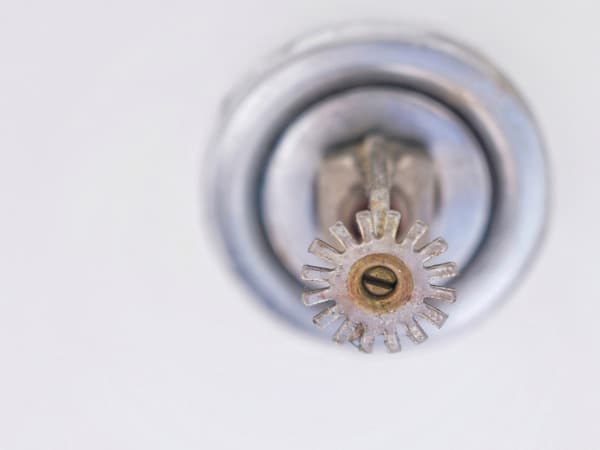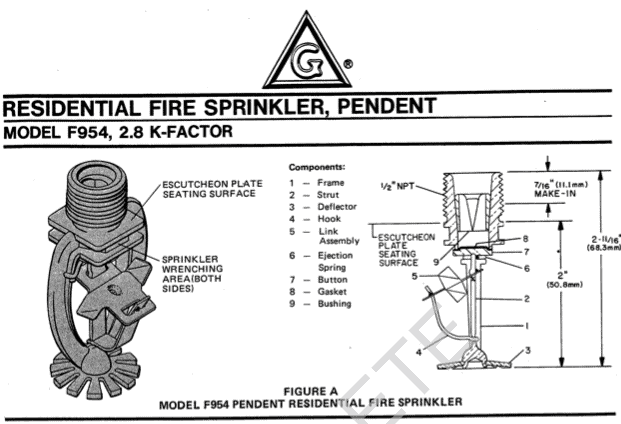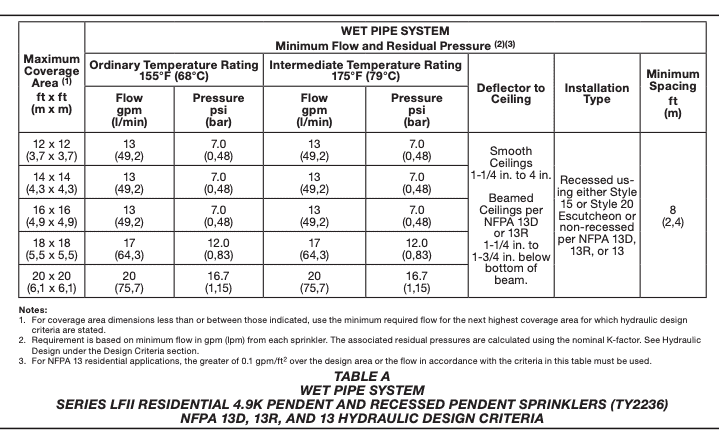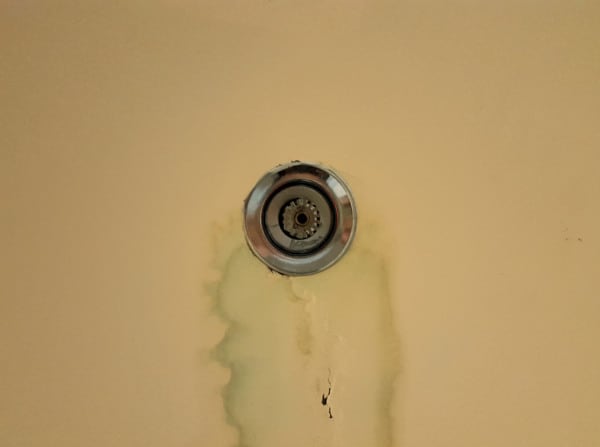The best practices and NFPA guidance for finding a suitable replacement home fire sprinkler
Residential fire sprinkler systems have existed for about 50 years, prompting the need for many home or building owners to replace old fire sprinkler heads. Whether it’s because of damage, activation, or simple age, you must either find an exact replacement — the same model, brand, and characteristics — or an equivalent fire sprinkler with features that meet the system’s design requirements.
Among the crucial specs that must closely match is the sprinkler’s K-Factor, a technical term that describes the size of the orifice and how much water comes out (how fast) at a given pressure and flow.
Unfortunately, some manufacturers have gone out of business or retired old models over the years, and the technical specs of home fire sprinklers have changed with evolving installation standards. This situation sometimes begs the question:
What if I need to replace residential fire sprinkler heads, but it has an obsolete or missing K-Factor?
This QRFS guide explains what to do, what the K factor of a sprinkler is, some design calculations explaining the number’s importance, and how the history of residential fire sprinklers has influenced these issues. We reference the National Fire Protection Association’s (NFPA) installation standards to explain specific rules:
- NFPA 13D: Standard for the Installation of Sprinkler Systems in One- and Two-Family Dwellings and Manufactured Homes
- NFPA 13R: Standard for the Installation of Sprinkler Systems in Low-Rise Residential Occupancies
- NFPA 13: Standard for the Installation of Sprinkler Systems. NFPA 13 isn’t a dedicated residential standard, and its systems aren’t the focus of this piece, but it does include various rules governing residential sprinklers. People use NFPA 13 for larger residential buildings or where owners don’t choose 13R or 13D because they want equal life safety and property protection.
You can read this entire blog for an in-depth look at this issue. But at a minimum, check out our summary of steps for replacing a sprinkler with an old or missing K-Factor:
1. Identify the sprinkler model, including its temperature classification, and try to find an exact replacement for sale. If you do, buy it!
2. If an exact replacement isn’t available, NFPA 13D, 13R, and 13 permit using an equivalent residential sprinkler with a K-Factor within +/- 5% of the old K-Factor. For example, an obsolete Viking Microfast Model M pendent residential sprinkler from 1988 has a 5.5 K-Factor. So, you might replace it with a modern Viking Freedom VK466 with a 5.2 K-Factor (-5%) at an equivalent temperature.
3. If you can’t find a replacement sprinkler within +/- 5% of the old model’s K-Factor, then a fire protection professional must do some calculations to see if the closest replacement options will work well. These essential specs include whether the new model accomplishes the old sprinkler’s intended coverage area at a given pressure and flow and meets the “minimum discharge density of 0.05 gpm/ft2 (2.0 mm/min)” that NFPA 13D first specified for all residential systems in 2002.
4. If you don’t know the K-Factor for an old sprinkler, similar but more detailed calculations are necessary. They include assessing how far sprinklers are from each other and the walls, the system’s pipe material and size, the available water pressure, and other factors. Again, the results can inform choosing a sprinkler that provides different but sufficient protection.
5. If necessary and with the calculations from Steps 3 or 4, you and a fire protection professional can speak to the authority having jurisdiction (AHJ) about waiving the +/- 5% K-Factor requirement. Technically, consulting an AHJ is not mandated by standards. But local rules might require it depending on construction-permitting needs for modifying an existing structure. Success here depends on making the case that any new replacement sprinklers provide adequate protection.
6. If the AHJ declines to use their discretion or the numbers just don’t work out, a significant recalculation and retrofit of the sprinkler system are needed. This effort, which may involve replacing pipes, sprinklers, and other steps, isn’t the most likely outcome. After all, residential sprinkler systems and the NFPA 13D and 13R installation standards are designed to be affordable and forgiving. But it’s possible!
With that summary complete, let’s get into more detail on why K-factor is essential and the calculations that inform the design requirements for sprinklers.
Need replacement fire sprinklers? Check out QRFS’s wide selection of residential fire sprinklers from Tyco, Viking, Senju, and Victaulic.

The NFPA 13D, 13R, and 13 rules for replacing old residential fire sprinkler heads
While automatic fire sprinkler systems have been around since the late 19th Century, their residential cousins are much younger.
The National Fire Protection Association (NFPA) published the first edition of NFPA 13D in 1975, and Grinnell Fire Protection manufactured the first listed residential fire sprinkler in 1981. At the time, the Grinnell Model F954 was the only model to meet the listing requirements in UL 1626, The Standard for Residential Sprinklers for Fire-Protection Service.
Both residential sprinklers and their installation standards have evolved in the years since. However, standards have maintained their guidance that the first option for sprinkler replacement is using the exact same model at the same temperature.
But if your residential sprinkler was manufactured over 20 years ago or otherwise discontinued, it may be impossible to find an exact replacement or a different model with the precise characteristics. Complicating matters is the fact that you might not be able to find the K-factor for older sprinklers at all; the number might not be apparent on the frame or deflector.
In addition, NFPA didn’t specify a 0.05 gpm/ft2 minimum discharge density for residential sprinklers until the 2002 edition of NFPA 13D. Instead, the old standards just set flow and spacing parameters. Thus, many sprinklers made and installed before 2003 had discharge densities ranging from about 0.032 gpm/ft2 to as high as 0.09 gpm/ft2.
Modern editions of NFPA 13D, 13R, and 13 attempt to account for these old sprinklers and their inconsistencies with the following guidance (the below references are in the 2022 editions):
12.3.2.1* (NFPA 13D)/5.1.1.2* (NFPA 13R)/19.3.1.4.1 (NFPA 13)
Where replacing residential sprinklers manufactured prior to 2003 that are no longer available from the manufacturer and are installed using a design density less than 0.05 gpm/ft2 (2.04 mm/min), a residential sprinkler with an equivalent K-factor (± 5 percent) shall be permitted to be used provided the currently listed coverage area for the replacement sprinkler is not exceeded.
A bit of confusion could arise because of how this section is written; specifically, this condition: “and are installed using a design density less than 0.05 gpm/ft2 (2.04 mm/min).” Many system owners won’t know whether their old fire sprinklers hit this density threshold — and it doesn’t really matter whether or not they do.
We spoke to an NFPA committee member who explained that these words intend to bring attention to the fact that there were sprinklers that delivered a lower water discharge level than is acceptable now. Thus, if an old sprinkler doesn’t hit 0.05 gpm/ft2, you are following this criterion to the letter. But if the old sprinkler exceeded that number but the new K-factor is within “± 5 percent,” the hole size is close enough.
The bottom line: if you know the old, unavailable sprinkler’s K-factor, you can replace it with a new residential sprinkler that has a K-factor within 5%.
Here’s another example of this scenario: an older sprinkler with a 3.9 K-Factor could be replaced with one of Senju’s 3.7 K-Factor models since the new K-Factor is within minus 5% of the old one.
Also note: Some proposals are moving through the committee process of writing the 2025 editions of NFPA 13D, 13R, and 13 that would simplify replacing old residential sprinklers. These proposed changes would allow system owners to replace sprinklers with new models that have the next highest K-Factor, not one that’s +/- 5%. However, as of this writing, the eventual outcome of these proposed changes is uncertain.
But what if you don’t know the old sprinkler’s K-factor at all? A qualified fire protection professional will have to do a more thorough examination of the system and try to find residential fire sprinkler heads that provide sufficient protection.
This process includes identifying the design area, measuring the distances between sprinklers and the walls, assessing the water supply’s pressure, and accounting for the system pipe material and its frictional impact on flow. In many cases, a fire protection pro can make the case that a new model will do the job well. If they can’t, more extensive system modifications may be needed.

Sprinkler system design: understanding “design area” and why the K-Factor of a sprinkler is important
It may be helpful to understand how fire protection professionals design residential fire sprinkler systems following NFPA 13D, 13R, and, less commonly, 13. The necessary water pressure, flow, and coverage to achieve effective fire protection are determined by figuring out what’s needed in the system’s “design area.”
The design area is the compartment in the structure with the most significant “hydraulic demand” — where the sprinklers need the most water and pressure to provide enough coverage. It’s typically the part of the building that’s the highest or furthest away from the water supply. The number of sprinklers in a given design area is:
- Up to two sprinklers in NFPA 13D systems installed in one-bedroom, two-bedroom, and manufactured homes, each hitting a minimum discharge density of 0.05 gpm/ft2.
- Up to four sprinklers in NFPA 13R systems installed in low-rise residential structures, each hitting a minimum discharge density of 0.05 gpm/ft2.
- A minimum of four sprinklers in NFPA 13 However, in this case, newly installed sprinklers must achieve a minimum discharge density of 0.1 gpm/ft2 or the manufacturer’s requirements, whichever is greater. Nevertheless, the same K-factor replacement rule of +/- 5% still applies for replacing residential heads — so we won’t get into all the complex factors (but you can read more about hydraulic demand here.)
Beyond the numerical differences in the installation standards, the basic principles of a design area remain the same. Designers assess the system’s hydraulic demand (how much water and pressure are needed) by looking at several factors and their impact on protecting the design area, including the type and size of the pipe, the water supply quantity and pressure, and the discharge characteristics of the individual sprinklers.
That last element is critical; individual residential fire sprinkler heads must be able to throw enough water far enough, backed by the proper water supply and pressure, to effectively contain a fire in the design area. So, each sprinkler head is tested and rated by various characteristics that include:
- The maximum coverage area in feet by feet (meters by meters) at a given flow and pressure.
- The minimum flow needed in gallons per minute (gpm — or liters per minute (lpm)) to hit a specific coverage area.
- The minimum residual water pressure in pounds per square inch (PSI — or Bar) at the discharging sprinkler.
- The K-Factor, aka the “coefficient of discharge.” Again, K-Factor is basically the size of the hole where the water comes out of the sprinkler head, indicating the amount it will spray at a given pressure and flow.
The relationship between all these elements, the design area, and hydraulic demand is pretty complicated. But there is the rule mentioned above: NFPA 13D and 13R now specify that all residential sprinkler systems need “a minimum discharge density of 0.05 gpm/ft2 (2.0 mm/min) or the sprinkler’s listing, whichever is greater” from the sprinklers in a design area (NFPA 13D: 10.1.1, NFPA 13R: 7.1.1.1).
We can illustrate how the discharge density is calculated with some basic math using specs from a Tyco TY2236 Residential Pendent sprinkler. Manufacturers outline the factors we mention below in a fire sprinkler’s data sheet, like this excerpt from the one for the Tyco TY223:

- The Tyco TY2236 has a 4.9 K-factor, which is interrelated with the below factors and demands specific amounts of flow and pressure to meet different coverage areas.
- Overall, the sprinkler has a maximum coverage area of 20 feet x 20 feet at a specific minimum flow and pressure. But for this example, it can also have a coverage area of 16 feet x 16 feet, which equals 256 square feet, at the specific flow and pressure in the following two points.
- The sprinkler needs a minimum of 7 PSI of residual pressure to operate adequately at 16 ft. x 16 ft.
- It also requires a flow of 13 gpm at 16 ft. x 16 ft.
Again, the minimum discharge density for a residential sprinkler is 0.05 gpm/ft2, and a simple calculation shows how this Tyco sprinkler achieves it:
At a specific minimum residual pressure, the resulting flow/coverage area = discharge density.
So, using the numbers from the table above: at a minimum residual pressure of 7 PSI, the 4.9K Tyco TY2236 has 13 gpm of flow/256 sq. ft. of coverage (16’ x 16’) = a 0.05 gpm/ft2 discharge density.
Thus, the Tyco TY2236 meets the minimum discharge density requirements at 16 feet by 16 feet. But what if a designer wants the same sprinkler to cover its upper limit of 20 feet by 20 feet instead?
In that case, notice how the minimum flow and pressure change in the above table — both must also increase for this sprinkler based on the 4.9 K-Factor:
At a minimum pressure of 16.7 PSI: 20 gpm of flow/400 sq. ft. of coverage = 0.05 gpm/ft2 discharge density.
As you can see, all these factors are related, and the discharge density depends on the sprinkler’s K-Factor. So, if you replace an old sprinkler with a new one that has different characteristics, it throws off the numbers. The amount of water the sprinklers in the design area will deliver based on the previously calculated hydraulic demand changes, altering the coverage area, flow, and discharge density.
And if the discharge density is too low (or even way too high), it’s a problem. The sprinklers may not be able to control a fire as designed — and maybe not effectively at all.

Replacing old residential fire sprinkler heads is supposed to be straightforward
If you have to replace old, discontinued residential fire sprinkler heads, review the steps mentioned at the top of this blog. And if you run into challenges finding an exact match or officially suitable replacement, all hope is not lost. NFPA aims for residential fire sprinkler installation and maintenance to be more forgiving than they are for commercial systems.
That’s because NFPA recognizes it’s crucial to make it as easy and affordable as possible for people to use residential fire sprinklers. It’s far more important to have many safely functioning systems rather than only a few that achieve design perfection.
Thus, if you experience issues, find a qualified fire protection professional to help you replace old fire sprinklers with a suitable model. And when you need to buy this equipment, check out QRFS’s wide selection of residential fire sprinklers.
Feel free to contact QRFS at 888-361-6662 or support@qrfs.com if you need help finding or ordering a specific product.
This blog was originally posted at QRFS.com/blog. If this article helped you, check us out at Facebook.com/QuickResponseFireSupply or on Twitter @QuickResponseFS.



